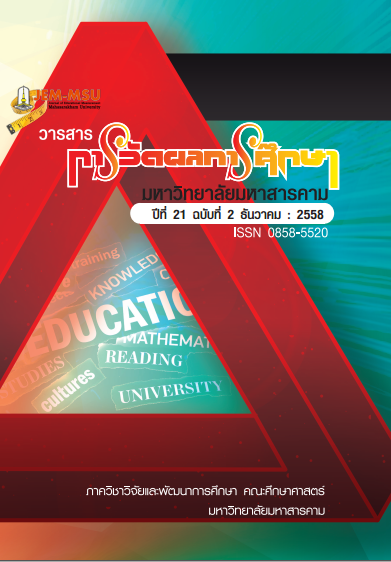The Development of English Language Reading Instructional Model through ASEAN Culture for Mattayomseuksa 2
Main Article Content
Abstract
Organization of integration learning was an important part to reorganize
learning; thus, reading by inter-disciplinary integration that integrates between English
and Social studies through ASEAN Culture, was a part of making students to develop
reading comprehension and can bring experience from English reading learning in
everyday life. The purposes of this research were to develop an English reading model
unit traditional of Asean for Mathayomsueksa 2 has efficiency of 75/75 and to study
the results of using an English reading model unit traditional of Asean 2. The sample
used in this research was 37 Mathayomsueksa 2/1 students by purposive sampling at
Khamssakaesang School, Nakhon Rachasima, during the first semester of academic year
2014. The instruments used in this research were: 1) a model of an English reading
instruction 2) English reading test has difficulty = 0.2 – 0.54 discrimination = 0.20 – 0.58
reliability = 0.78, and 3) the attitude scale toward English has discrimination = 0.37 –
0.96 and reliability = 0.93. Data were analyzed by percentage, mean, standard
deviation and hypotheses testing by used t-test (Dependent Samples).
The research results were as follows;
1. English Language Reading Instructional Model through ASEAN Culture
for Matthayomsueksa 2 by inter-disciplinary integration that integrate between English
and Social studies through ASEAN Culture, consisted of 6 elements; concepts and
basic theories, objective, procedure in learning activities organization, social system,
and principles of response and support system, had appropriately effective, had an
efficiency of 78.62/78.38.
2. The results are the students who learned following this model had a
higher score on English reading ability than those who did not learn by this model;
was significantly higher than before learning at .05 level of significance and the
students’ attitude toward English is in the high level.
Article Details
The content and information contained in the published article in the Journal of Educational Measurement Mahasarakham University represent the opinions and responsibilities of the authors directly. The editorial board of the journal is not necessarily in agreement with or responsible for any of the content.
The articles, data, content, images, etc. that have been published in the Journal of Educational Measurement Mahasarakham University are copyrighted by the journal. If any individual or organization wishes to reproduce or perform any actions involving the entirety or any part of the content, they must obtain written permission from the Journal of Educational Measurement Mahasarakham University.


